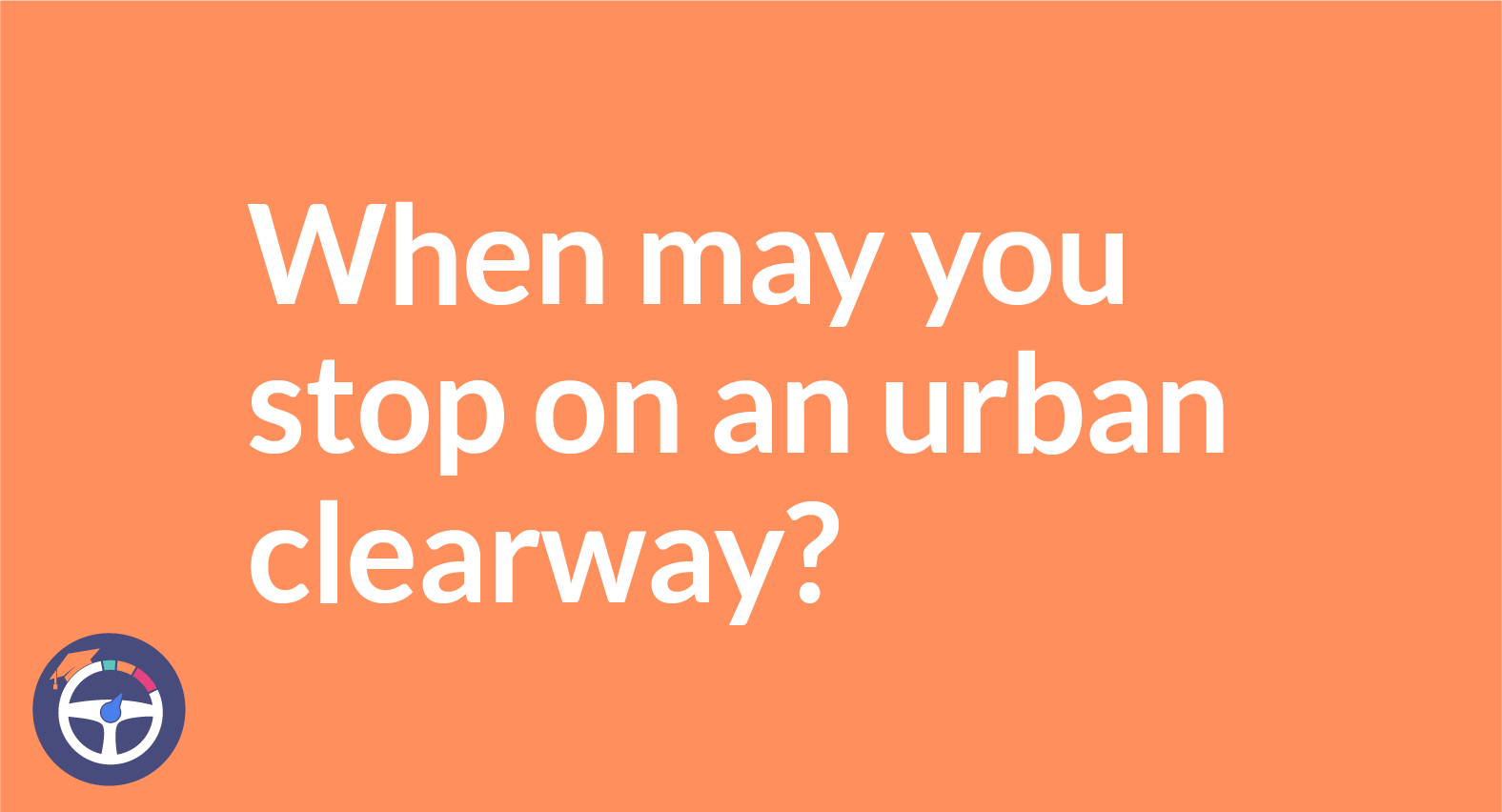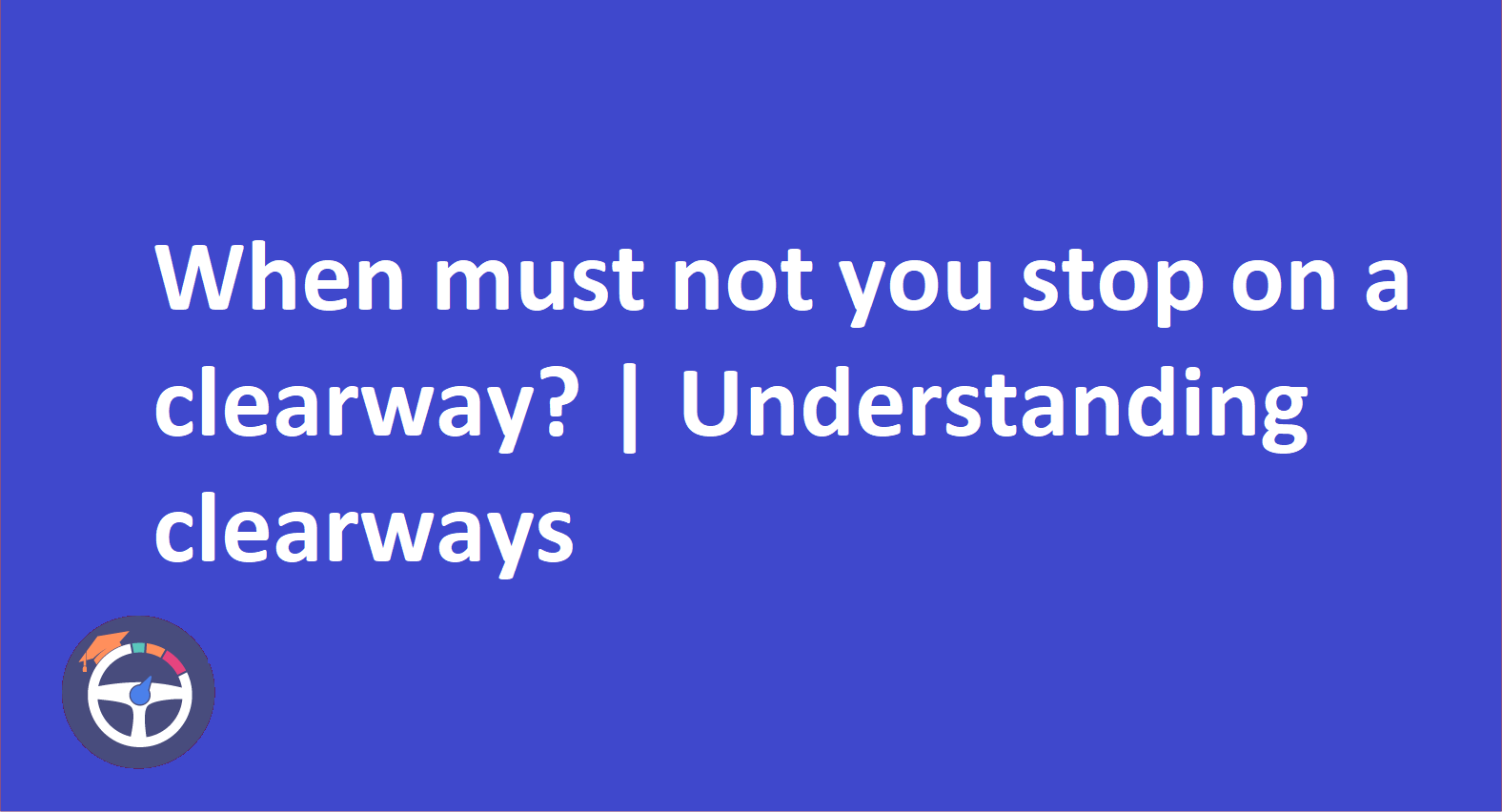When may you stop on an urban clearway?
Urban clearways are often located in built-up areas, and their operating times will be clearly displayed. You should only stop for a reasonable duration to pick up or drop off passengers, making sure you are not obstructing other traffic

Contents
- Urban Clearway Signs: When Can You Stop?
- Urban Clearway Sign Meaning
- When May You Stop On An Urban Clearway
- Can Vehicles Park In Urban Clearways?
- What Restrictions Apply In Clearway Zones?
- What Defines A Red Route Clearway?
- How Do Red Routes Differ From Urban Clearways?
- That’s A Wrap!
- FAQ
Let's talk about signs on city roads – urban clearways. They're like traffic conductors, guiding us on when we can and can't stop. Ever wondered about that? Well, let's break it down!
Urban Clearway Sign Meaning
So, whats an urban clearway? The Urban Clearway sign signifies no stopping or parking on the designated road, ensuring a smooth traffic flow. It aims to prevent congestion in busy urban areas. However, a brief stop for passenger drop-off or pick-up is permitted.
When May You Stop On An Urban Clearway
Traversing urban landscapes requires a keen understanding of road rules, and urban clearway signs serve as guides, directing you to maintain an uninterrupted traffic flow. You are driving on an urban clearway, can you stop in an urban clearway? The answer involves a nuanced consideration.
In general, stopping is discouraged in urban clearways to ensure seamless traffic flow and reduce congestion. However, there exists a crucial exception – you are permitted to stop momentarily for the purpose of setting down or picking up passengers.
It's crucial to emphasize that this exception does not grant permission for extended stops. The key is to keep the pause brief – execute the drop-off or pick-up swiftly and seamlessly integrate back into the traffic flow. Urban clearways prioritize the continuous movement of vehicles, so make your stops crisp and purpose-driven.
When faced with urban clearway signs, stopping is generally restricted. But the exception for setting down or picking up passengers allows for a quick pause. Armed with this knowledge, you're equipped to navigate urban roads with confidence and compliance.
Can Vehicles Park In Urban Clearways?
In urban clearways, parking is strictly prohibited. These areas are designated to maintain a continuous flow of traffic, ensuring that roads remain unobstructed and congestion-free. The primary objective of urban clearways is to facilitate the smooth movement of vehicles without unnecessary interruptions.
Parking restrictions in urban clearways contribute to efficient traffic management, especially in busy urban environments. The emphasis is on keeping these lanes clear for vehicles in motion, reducing the likelihood of traffic jams and improving overall road safety.
Drivers should be attentive to clearway signage and refrain from parking in these designated zones. While general parking is not allowed, there is a specific exception that permits a brief stop for setting down or picking up passengers. However, this exception is limited to quick and purposeful stops, with the intention of minimizing disruptions to the flow of traffic.
It's essential for drivers to stick to these regulations. It will ensure the effective functioning of urban clearways. It will also help contribute to a seamless and safe driving experience. Knowing and following these rules helps maintain the efficiency of urban road networks. It also promotes responsible and considerate driving behavior.
What Restrictions Apply In Clearway Zones?
Clearway zones come with specific restrictions to ensure the smooth flow of traffic and prevent congestion. Here's a detailed explanation of the restrictions that typically apply in clearway zones:
- No Stopping or Parking: The primary restriction in clearway zones is that vehicles are not allowed to stop or park along the designated stretch of road. This rule aims to maintain a continuous flow of traffic and prevent unnecessary delays.
- No Waiting: In addition to no stopping or parking, clearway zones often have restrictions against waiting. Drivers cannot linger or wait for extended periods in these areas.
- Loading and Unloading Restrictions: While clearways generally prohibit stopping. But there is often an exception for loading and unloading passengers. However, this is usually allowed only for a brief period. It requires the driver to actively engage in these activities without causing traffic disruptions.
- Quick Passenger Set Down and Pick Up: Clearways may allow a quick set down and pick up of passengers. But this should be done efficiently to avoid hindering the movement of traffic.
- Continuous Traffic Flow: The overarching goal of clearway restrictions is to maintain a continuous flow of traffic. Especially during peak hours or in areas prone to congestion.
- Clearway Signage: Clearway zones are typically marked with specific road signs indicating the restrictions. Drivers should pay close attention to these signs to comply with the rules of the clearway.
- Enforcement: Clearways are actively monitored and enforced by traffic authorities. Violations, such as stopping or parking in clearway zones, can result in fines or penalties.
Understanding and adhering to these restrictions is crucial for drivers to contribute to efficient traffic management, enhance road safety, and avoid legal consequences. Compliance with clearway regulations helps ensure a smooth and unobstructed flow of vehicles, particularly in areas with high traffic volumes.
What Defines A Red Route Clearway?
A red route clearway refers to a specific type of road designated with red lines or markings to indicate certain restrictions and regulations. Here's a detailed explanation of what defines a red route clearway:
- Red Markings: Red route clearways are easily identifiable by red lines or markings along the edges of the road. These markings typically extend for the entire length of the route.
- Traffic Management: The purpose of red route clearways is to efficiently manage traffic flow in busy urban areas. These routes are strategically chosen to minimize congestion and maintain a smooth movement of vehicles.
- Parking Restrictions: One of the key features of a red route clearway is the strict prohibition of stopping or parking along the marked areas. This restriction aims to keep the lanes clear for the continuous flow of traffic.
- Loading and Unloading Restrictions: Similar to other clearways, red route clearways may have restrictions on loading and unloading. Any such activities are typically limited to specific times and durations.
- No Waiting: Waiting is generally not allowed in red route clearways. Drivers are expected to keep the lanes clear and avoid lingering in these areas.
- Clearway Signage: Red route clearways are accompanied by clear signage indicating the restrictions in place. Drivers should pay close attention to these signs to ensure compliance.
- Strict Enforcement: Red route clearways are actively monitored and enforced by traffic authorities. Violating the regulations, such as parking or waiting in these areas, can result in fines or penalties.
- Efficient Traffic Movement: The primary goal of red route clearways is to facilitate efficient traffic movement, especially in areas with high traffic density or where congestion is a common issue.
Understanding the specific rules and regulations associated with red route clearways is essential for drivers navigating urban environments. Adhering to these restrictions contributes to a more organized and fluid traffic system, benefiting both drivers and pedestrians.
How Do Red Routes Differ From Urban Clearways?
Red routes and urban clearways share similarities in terms of traffic management and restrictions, but there are key differences that distinguish the two. Here's an explanation of how red routes differ from urban clearways:
Color of Markings:
Urban Clearways: Urban clearways are marked with clearway restrictions, often indicated by single or double yellow lines at the edge of the road.
Red Routes: Red routes, as the name suggests, have distinctive red lines or markings along the edges of the road.
Purpose and Scope:
Urban Clearways: Urban clearways are designed to manage traffic flow in urban areas and prevent congestion. They may be found in city centers or areas with high traffic volumes.
Red Routes: Red routes are a specific type of urban clearway that often covers major roads and important transportation corridors. The emphasis is on maintaining efficient traffic movement on critical routes.
Parking Restrictions:
Urban Clearways: Parking restrictions apply, and vehicles are generally not allowed to stop or park along the clearway.
Red Routes: Similar to urban clearways, red routes strictly prohibit stopping or parking. The red markings serve as a clear indication of these restrictions.
Loading and Unloading:
Urban Clearways: Loading and unloading may be permitted during specific times and under certain conditions.
Red Routes: Loading and unloading activities are subject to restrictions, often limited to designated times and areas.
Signage:
Urban Clearways: Marked with road signs indicating clearway restrictions, typically accompanied by yellow lines.
Red Routes: Clearly signposted with red route signage, providing drivers with information about the specific regulations in place.
Enforcement:
Urban Clearways: Enforcement is carried out to ensure compliance with parking and stopping restrictions.
Red Routes: Strict enforcement is applied to red routes, and penalties may be imposed for violations to maintain the efficiency of major transportation arteries.
Understanding these distinctions is crucial for drivers to navigate urban areas and comply with local traffic regulations. While both red routes and urban clearways aim to facilitate smoother traffic flow, red routes typically have a broader scope and strategic significance in the overall transportation network.
That’s A Wrap!
Urban clearway signs guide drivers to prioritize continuous traffic flow, minimizing congestion for a safer and more efficient driving experience. Remember, when may you stop on an urban clearway is important. Also, while stopping is generally discouraged in these zones, a brief pause for setting down or picking up passengers is permissible. Stay informed, follow the rules, and ensure your stops are purpose-driven, contributing to a smoother urban traffic landscape. Happy driving!
FAQ
1. Can I load or unload goods in an urban clearway?
No, urban clearways generally do not permit loading or unloading activities. Check local regulations for specific details.
2. Are there specific times when stopping is allowed in a red route clearway?
Red route clearways may have designated times for specific activities. It's crucial to observe signs and markings for accurate information.
3. Do clearway restrictions apply 24/7?
Clearway restrictions may vary, and some may be in effect 24/7. Always check road signs for the precise details of clearway regulations.
4. Are there penalties for violating clearway restrictions?
Yes, there are penalties for violations, including fines and potential towing of the vehicle. Local authorities actively enforce clearway regulations.
5. Can I wait briefly in an urban clearway?
Waiting, even briefly, is generally not allowed in urban clearways. These zones prioritize continuous traffic flow, so it's advisable to avoid any form of waiting.


